Tesla Model S
Charging the Tesla Model S with the HPWC
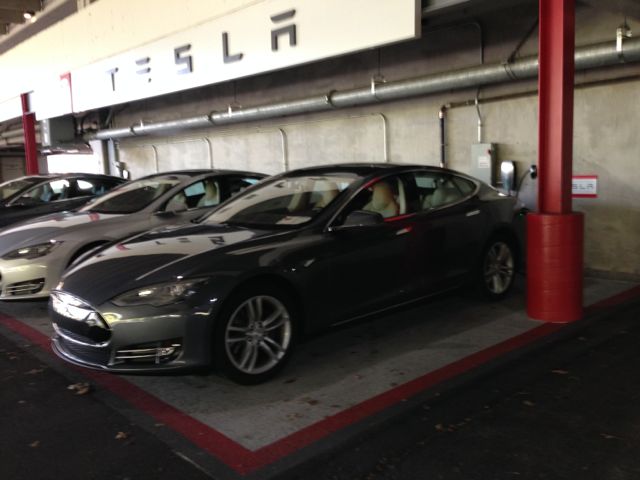
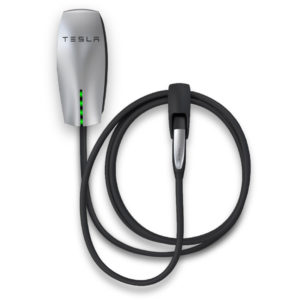 When I was buying my Model S I decided that I didn’t need the High Power Wall Charger (HPWC), but I did go with the dual chargers. At home I regularly charge on a NEMA 14-50 which gives me about 28 miles per 1 hour of charge, but with the onboard dual chargers it’s possible to double that rate provided you’re using the proper charger.
When I was buying my Model S I decided that I didn’t need the High Power Wall Charger (HPWC), but I did go with the dual chargers. At home I regularly charge on a NEMA 14-50 which gives me about 28 miles per 1 hour of charge, but with the onboard dual chargers it’s possible to double that rate provided you’re using the proper charger.
My office is across the street from the Tesla store in Natick, MA and they have free charging available in 6 parking spots with a couple of HPWCs a short walk away. The other day I skipped my nightly charge and parked in one of the HPWC spots at the mall for a charge the next morning.
Tesla HPWC
The HPWC does not require any special adapters or additional cables and simply plugs into the Model S. It charges at up to 80A when equipped with the Model S dual chargers, but even without it things still work – just at half the charge rate. That’s what I love about the Tesla. Even if you know nothing about voltages, amperages and watts, things just work. Just plug, play and Tesla manages the rest.
Charging
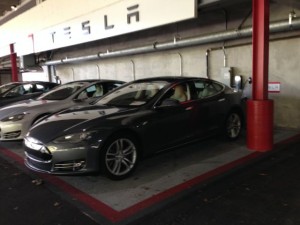 Unlike the Tesla Supercharger which uses a direct current (DC) that bypasses the onboard chargers, the HPWC uses a more traditional alternating current (AC) approach, but with a very high amp draw.
Unlike the Tesla Supercharger which uses a direct current (DC) that bypasses the onboard chargers, the HPWC uses a more traditional alternating current (AC) approach, but with a very high amp draw.
There are very few public chargers out there that can charge at over 40A, and the ones that do probably don’t have a Tesla Model S adapter such as the CHAdeMO.
Editor’s note: Tesla Motors loaned PlugShare a custom CHAdeMO to Model S adapter for their epic 12,000+ mile journey.
The Model S has the ability to charge at different amperages depending on your setting. The rate is limited by both your car’s ability (40A or 80A for single or dual chargers respectively) and the maximum draw allowed by your power source. Make sure your charge rate is set to the highest limit before plugging into a HPWC in order to maximize your rate of charge. The charge rate settings should be auto-memorized by the vehicle based on your GPS location.
Charge Rate
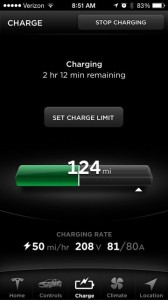 After I confirmed that the car was charging, I walked to my office while monitoring my state of charge through the iOS app. It reported the charge rate to be about 50 miles/hour (208v at 81A) which confirmed that my dual chargers were working since I was charging twice as fast as my home NEMA 14-50.
After I confirmed that the car was charging, I walked to my office while monitoring my state of charge through the iOS app. It reported the charge rate to be about 50 miles/hour (208v at 81A) which confirmed that my dual chargers were working since I was charging twice as fast as my home NEMA 14-50.
To validate the rate of charge I timed the charge and recorded the reported rated range. I started charging at 8:30am and stopped at 11:07 AM (a 90% charge limit was set). I went from 106 miles of rated range to 240 miles of rated range. So I added 134 miles in 2.6 hours for an actual charge rate of 51.2 miles/hour.
I’ve heard about charge rates tapering off as your near the upper limits of your charge, but in my case it charged at the same rate all the way to a 90% limit. I’m assuming that the charge rate begins to slow down after the 90% mark, but unfortunately I didn’t have a chance to confirm that this time around.
Summary
My main goal was to be able to test my onboard dual chargers – something I debated long and hard on when ordering my Model S. I wanted to see them in action and gain peace of mind that they’re there and ready for fast charging if I should one day need it while on the road without access to a Tesla Supercharger.
The HPWC worked great and provided a high rate of charge that was twice the speed of my home NEMA 14-50. But even with that I still don’t think a HPWC at home is really needed.
Also see: Every New Tesla Owner’s Dilemma: Dual Chargers vs High Power Wall Connector (HPWC)

News
Tesla shocks with latest Robotaxi testing move
Why Tesla has chosen to use a couple of Model S units must have a reason; the company is calculated in its engineering and data collection efforts, so this is definitely more than “we just felt like giving our drivers a change of scenery.”

Tesla Model S vehicles were spotted performing validation testing with LiDAR rigs in California today, a pretty big switch-up compared to what we are used to seeing on the roads.
Tesla utilizes the Model Y crossover for its Robotaxi fleet. It is adequately sized, the most popular vehicle in its lineup, and is suitable for a wide variety of applications. It provides enough luxury for a single rider, but enough room for several passengers, if needed.
However, the testing has seemingly expanded to one of Tesla’s premium flagship offerings, as the Model S was spotted with the validation equipment that is seen entirely with Model Y vehicles. We have written several articles on Robotaxi testing mules being spotted across the United States, but this is a first:
🚨 Tesla is using Model S vehicles fitted with LiDAR rigs to validate FSD and Robotaxi, differing from the Model Ys that it uses typically
Those Model Y vehicles have been on the East Coast for some time. These Model S cars were spotted in California https://t.co/CN9Bw5Wma8 pic.twitter.com/UE55hx5mdd
— TESLARATI (@Teslarati) December 11, 2025
Why Tesla has chosen to use a couple of Model S units must have a reason; the company is calculated in its engineering and data collection efforts, so this is definitely more than “we just felt like giving our drivers a change of scenery.”
It seems to hint that Tesla could add a premium, more luxury offering to its Robotaxi platform eventually. Think about it: Uber has Uber Black, Lyft has Lyft Black. These vehicles and services are associated with a more premium cost as they combine luxury models with more catered transportation options.
Tesla could be testing the waters here, and it could be thinking of adding the Model S to its fleet of ride-hailing vehicles.
Reluctant to remove the Model S from its production plans completely despite its low volume contributions to the overall mission of transitioning the world to sustainable energy, the flagship sedan has always meant something. CEO Elon Musk referred to it, along with its sibling Model X, as continuing on production lines due to “sentimental reasons.”
However, its purpose might have been expanded to justify keeping it around, and why not? It is a cozy, premium offering, and it would be great for those who want a little more luxury and are willing to pay a few extra dollars.
Of course, none of this is even close to confirmed. However, it is reasonable to speculate that the Model S could be a potential addition to the Robotaxi fleet. It’s capable of all the same things the Model Y is, but with more luxuriousness, and it could be the perfect addition to the futuristic fleet.
News
Tesla Model S makes TIME’s list of Best Inventions
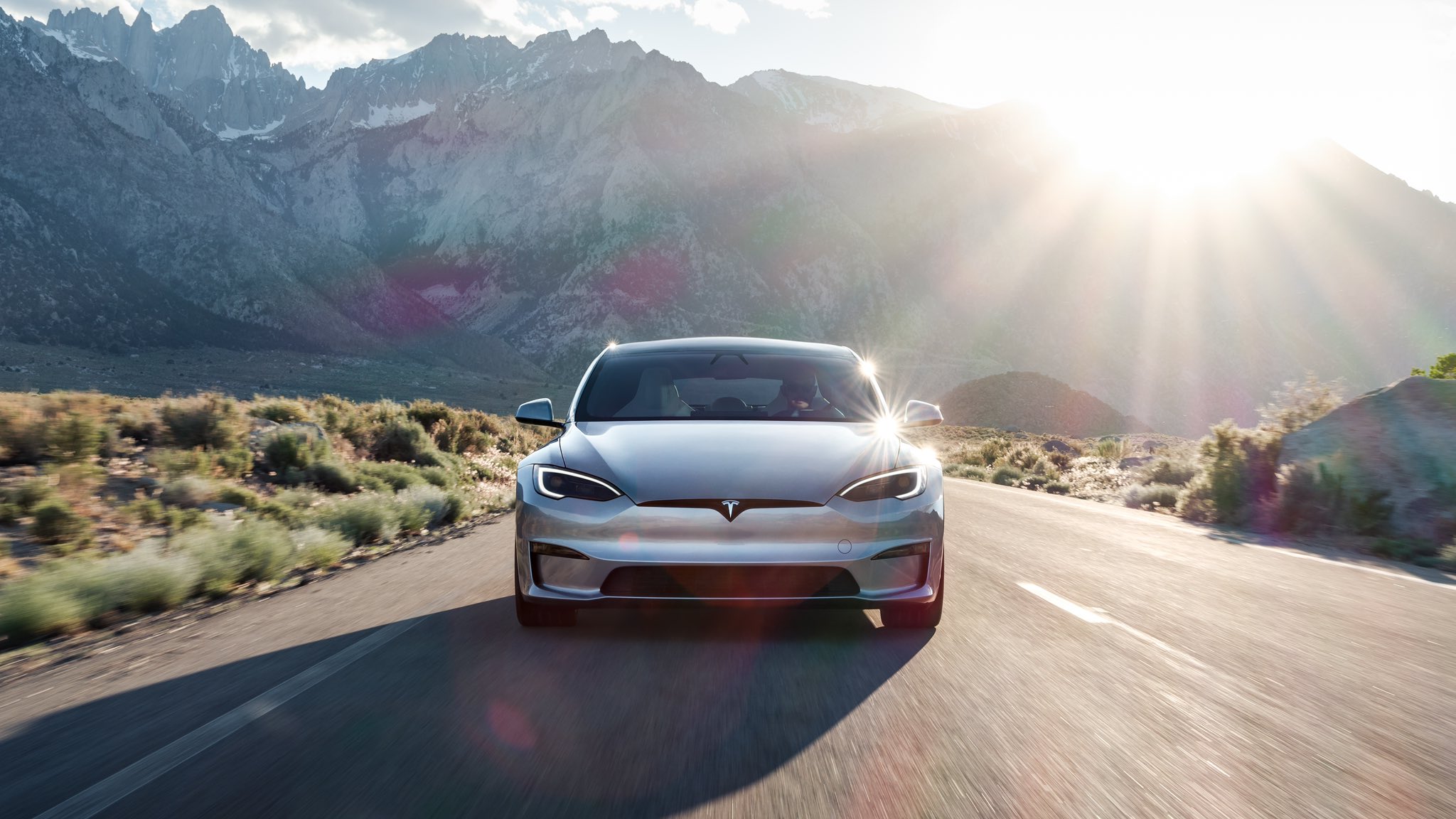
Tesla’s flagship sedan, the Model S, has officially been named one of TIME Magazine’s Best Inventions of the 2000s. It joins its sibling, the Model 3, which made the list in 2017.
The Model S is among the most crucial developments in the automotive industry in the last century.
Just as the Ford Model T made its mark on passenger transportation, becoming the first combustion engine vehicle to be successfully developed and marketed at a time when horse and buggy were the preferred mode of transportation, the Model S revolutionized things a step further.
Although it was not the first EV to be developed, the Tesla Model S was the EV that put EVs on the map. In 2012, TIME recognized the Model S as a piece of technology that could truly transform the car industry.
The publication wrote:
“This electric four-door sedan has the lines of a Jaguar, the ability to zip for 265 miles (426 km) on one charge—that’s the equivalent of 89 m.p.g. (2.6 L/100 km)—and touchscreen controls for everything from GPS navigation to adjusting the suspension.”
Looking back, TIME was right on. The Tesla Model S was truly a marvel for its time, and it, along with the OG 2008 Roadster, can be seen as the first two EVs to push electrification to the mainstream.
As TIME described this year, the Model S “proved to be a game-changing experience for electric vehicles,” and it ended up truly catalyzing things for not only the industry, but Tesla as well.
The Model S acted as a fundraiser of sorts for future vehicles, just as the Model X did. They paved the way for the Model 3 and Model Y to be developed and offered by Tesla at a price point that was more acceptable and accessible to the masses.
The Current State of the Tesla Model S
The Model S contributes to a very small percentage of Tesla sales. The company groups the Model S with the Model X and Cybertruck in its quarterly releases.
Last year, that grouping sold 85,133 total units, a small percentage of the 1.789 million cars it delivered to customers in 2024.
Things looked to be changing for the Model S and the Model X this year, as Tesla teased some improvements to the two cars with a refresh. However, it was very underwhelming and only included very minor changes.
Lucid CEO shades Tesla Model S: “Nothing has changed in 12 years now”
It appeared as if Tesla was planning to sunset the two cars, and while it has not taken that stance yet, it seems more likely that the company will begin taking any potential options to heart.
CEO Elon Musk said a few years ago that the two cars were only produced due to “sentimental reasons.”
Lifestyle
Tesla Model S Plaid battles China’s 1500 hp monster Nurburgring monster, with surprising results
There is just something about Tesla’s tuning and refinement that makes raw specs seem not as game-changing.
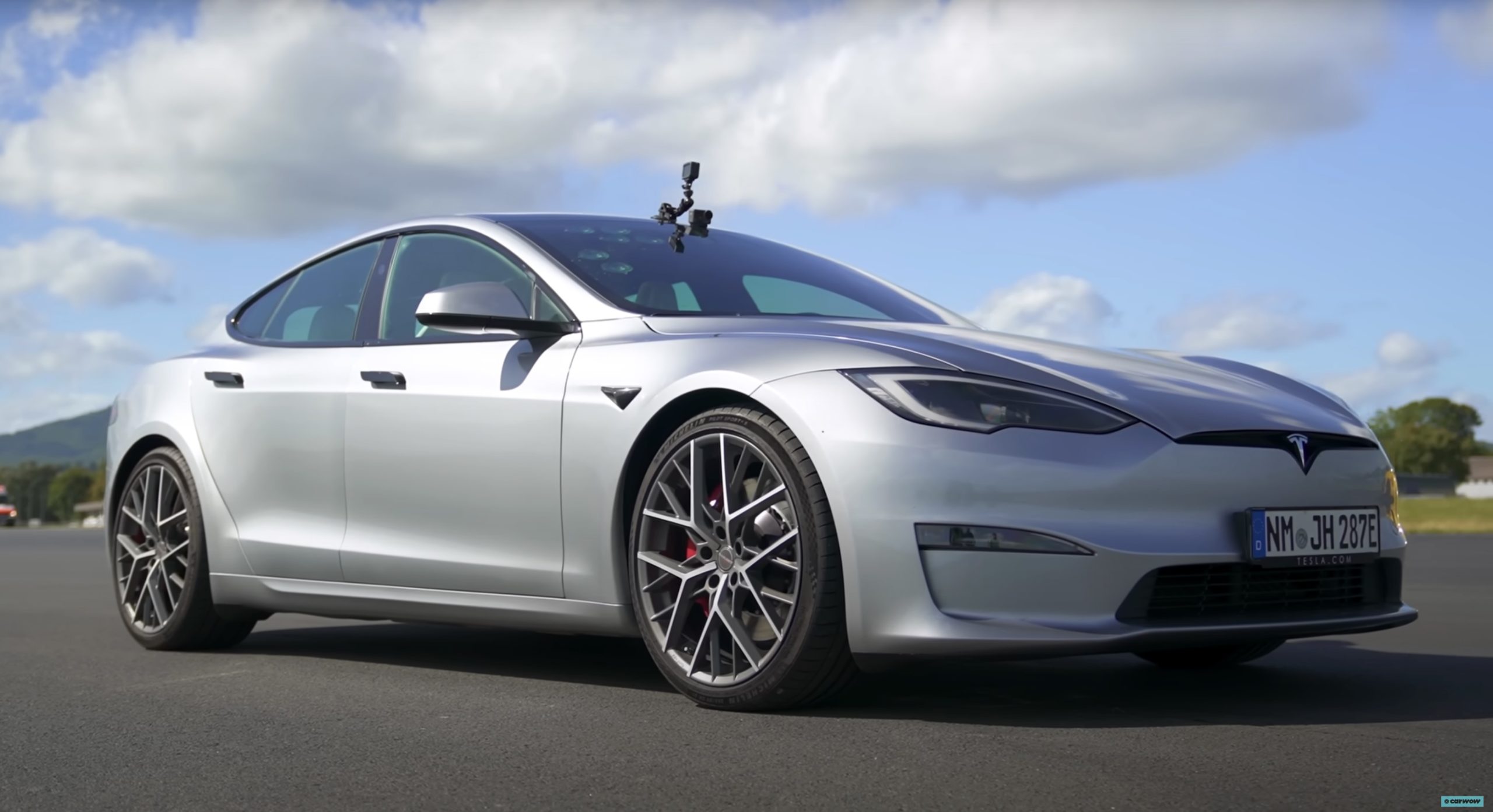
The Tesla Model S Plaid has been around for some time. Today, it is no longer the world’s quickest four-door electric sedan, nor is it the most powerful. As per a recent video from motoring YouTube channel Carwow, however, it seems like the Model S Plaid is still more than a match for some of its newer and more powerful rivals.
The monster from China
The Xiaomi SU7 Ultra is nothing short of a monster. Just like the Model S Plaid, it features three motors. It also has 1,548 hp and 1,770 Nm of torque. It’s All Wheel Drive and weighs a hefty 2,360 kg. The vehicle, which costs just about the equivalent of £55,000, has been recorded setting an insane 7:04.957 at the Nurburgring, surpassing the previous record held by the Porsche Taycan Turbo GT.
For all intents and purposes, the Model S Plaid looked outgunned in Carwow’s test. The Model S Plaid is no slouch with its three motors that produce 1,020 hp and 1,420 Nm of torque. It’s also a bit lighter at 2,190 kg despite its larger size. However, as the Carwow host pointed out, the Model S Plaid holds a 7:25.231 record in the Nurburgring. Compared to the Xiaomi SU7 Ultra’s record, the Model S Plaid’s lap time is notably slower.
Real-world tests
As could be seen in Carwow’s drag races, however, Tesla’s tech wizardry with the Model S Plaid is still hard to beat. The two vehicles competed in nine races, and the older Model S Plaid actually beat its newer, more powerful counterpart from China several times. At one point in the race, the Xiaomi SU7 Ultra hit its power limit due to its battery’s temperature, but the Model S Plaid was still going strong.
The Model S Plaid was first teased five years ago, in September 2020 during Tesla’s Battery Day. Since then, cars like the Lucid Air Sapphire and the Xiaomi SU7 Ultra have been released, surpassing its specs. But just like the Model Y ended up being the better all-rounder compared to the BYD Sealion 7 and the MG IM6, there is just something about Tesla’s tuning and refinement that makes raw specs seem not as game-changing.
Check out Carwow’s Model S Plaid vs Xiaomi SU7 drag race video below.








